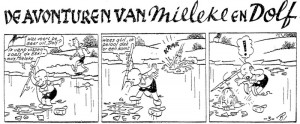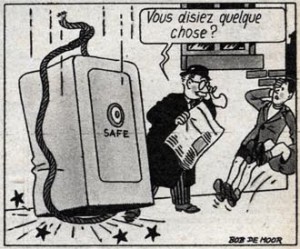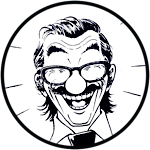In 1949 Ons Volkske started to publish the adventures of Mieleke & Dolf / Fee & Fonske which was also published in the Flemish weekly Kuifje. In French the series was known as Bouboule & Noiraud from the publications in Junior – from 1954 on – and in the Journal Tintin – from 1949 on. This series has unfortunately never been published in book format, except for an extremely limited run (we talk about 50 copies at maximum) via Jean-Pierre Verheylewegen in 2001 (or 2002), and even this publication didn’t include those strips published in the Journal Tintin. The family De Moor was so kind to provide us with material from this publication, more specifically we’ll show you the 3rd strip of this series as published on January 27, 1949 in Ons Volkske.

The one strip gag “De avonturen van Melee en Dolf” is part of the many series Bob De Moor saw published at the end of the 40s in magazines and youth extra’s for newspapers. Other series that consisted of one strip cartoons included the adventures of Vodje, Kareltje or yet De Rosse. They all have in common that they also never have been published in book format (except for the above mentioned limited run). Note that not all the cartoons were published as a strip. De Rosse for instance was often published as a square with 4 frames. The same happened once to Mieleke & Dolf when the Journal Tintin published the cartoon as a vertically positioned 3-frame strip to better fit the page layout.

The whole is a typical example of the typical flemish one strip cartoons which were independent from each other and as such never needed a cliff hanger, just a joke. Situation humor is key in such case. The jokes remind a lot of the early one page gags of Hergé‘s Quick & Flupke. On the flemish side of the comic world you could compare the type of humor with the one you could find in the early cartoons of Jommeke which Jef Nys would create in 1955 for the catholic weekly Kerk en Leven (also known in Flanders as ‘het parochieblad’). Truth to be told, Nys used a full page to develop his gags whereas Bob De Moor only used 3 to 4 frames at maximum. Sometimes De Moor would use plenty of dialogues but mostly the dialogues were quite limited.
Over the years the style in which the comic was drawn changed quite a bit, from the loosely drawn first strips as you can see here to a graphically more styled duo as published in the Journal Tintin. In the cartoons published for the Journal Tintin you clearly start to notice the influence of Hergé‘s style of drawing, less ‘bubly’, more refined. You could also say that he seemed to have had more time to finish the drawings although one must admit that the strips created for Mieleke & Dolf are amongst the finest cartoon style work De Moor would develop in the late 1940s.
